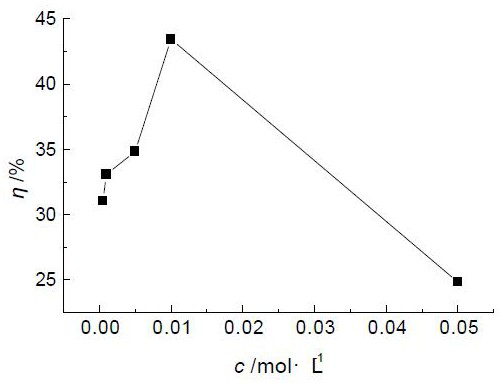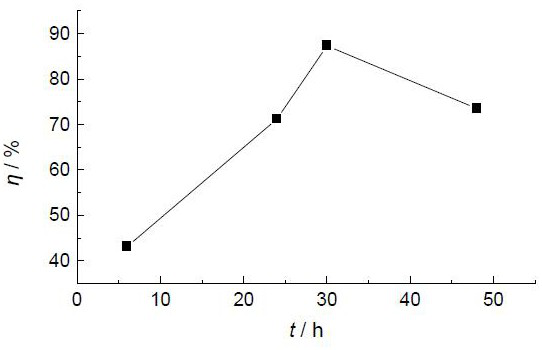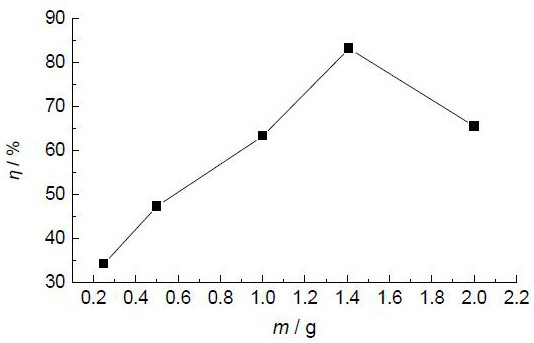A method for catalytically removing bisphenol-A by using coke-loaded biocl
A technology for coke removal, applied in chemical instruments and methods, physical/chemical process catalysts, chemical/physical processes, etc., can solve the problems of difficult regeneration and high cost
- Summary
- Abstract
- Description
- Claims
- Application Information
AI Technical Summary
Problems solved by technology
Method used
Image
Examples
Embodiment 1
[0027] 1) Coke pretreatment: Crush large pieces of coke and select coke with a particle size of 5-7 mm; wash with distilled water several times until the upper liquid has no black floating powder; dry in a far-infrared rapid constant temperature drying oven at 403 K for 2 h to constant weight.
[0028] 2) Modification of coke
[0029] Weigh an appropriate amount of pretreated coke into a beaker, soak it in 20% NaOH for 36 h (the liquid level is above the coke, seal it, and store it in the dark at room temperature); after 36 h, wash it with ultrasonic water. Firstly, the alkali-soaked coke was ultrasonically washed twice with a solution of water and ethanol with a volume ratio of 1:1, and then washed with deionized water for 5-6 times (stirring while washing with water during the ultrasonic washing process), and the washing time for each time was 7 min until the upper liquid is not cloudy. After ultrasonic washing, the coke was dried in a far-infrared rapid constant temperatu...
Embodiment 2
[0037] 1) Pretreatment of coke: crush large pieces of coke and select coke with a particle size of 5-7 mm; use distilled water to wash several times until the upper liquid has no black floating powder; Heavy.
[0038] 2) Modification of coke
[0039] Weigh an appropriate amount of pretreated coke into a beaker, soak it in 20% NaOH for 30 h (the liquid level is above the coke, seal it, and store it in the dark at room temperature); after 30 h, wash it with ultrasonic water. First, the alkali-soaked coke was ultrasonically washed 3 times with a solution of water and ethanol with a volume ratio of 1:1, and then washed 5-6 times with deionized water (stirring while washing with water during the ultrasonic washing process), and the cleaning time for each time was 7 min until the upper liquid is not cloudy. After ultrasonic washing, the coke was dried in a far-infrared rapid constant temperature drying oven at 400 K for 2 h to obtain alkali-modified coke.
[0040] 3) Preparation ...
Embodiment 3
[0047] 1) Pretreatment of coke: crush large pieces of coke and select coke with a particle size of 5-7 mm; use distilled water to wash several times until the upper liquid has no black floating powder; Heavy.
[0048] 2) Modification of coke
[0049] Weigh an appropriate amount of pretreated coke into a beaker, soak it in 20% NaOH prepared for 40 h (the liquid level is above the coke, seal it, and store it in the dark at room temperature); after 40 h, wash it with ultrasonic water. First, the alkali-soaked coke was ultrasonically washed 3 times with a solution of water and ethanol with a volume ratio of 1:1, and then washed 5-6 times with deionized water (stirring while washing with water during the ultrasonic washing process), and the cleaning time for each time was 7 min until the upper liquid is not cloudy. After ultrasonic washing, the coke was dried in a far-infrared rapid constant temperature drying oven at 400 K for 2 h to obtain alkali-modified coke.
[0050] 3) Pre...
PUM
| Property | Measurement | Unit |
|---|---|---|
| particle diameter | aaaaa | aaaaa |
Abstract
Description
Claims
Application Information
 Login to View More
Login to View More - R&D
- Intellectual Property
- Life Sciences
- Materials
- Tech Scout
- Unparalleled Data Quality
- Higher Quality Content
- 60% Fewer Hallucinations
Browse by: Latest US Patents, China's latest patents, Technical Efficacy Thesaurus, Application Domain, Technology Topic, Popular Technical Reports.
© 2025 PatSnap. All rights reserved.Legal|Privacy policy|Modern Slavery Act Transparency Statement|Sitemap|About US| Contact US: help@patsnap.com



